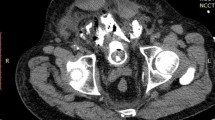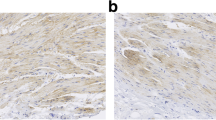Abstract
Objectives
Bladder perforation is the second most common complication during transurethral resection of bladder tumours. It is unknown whether perforation affects the natural history of the tumour through cell seeding. The aim of this study was to study the impact of perforation on the oncologic outcomes of bladder carcinoma.
Materials and methods
Between 2003 and 2007, 926 consecutive patients underwent transurethral resection of bladder tumours at our institution; 327 cases were staged ≥pT2 and were treated immediately with cystectomy and/or multimodal therapy and therefore excluded from the study. An additional 34 cases without urothelial carcinoma were excluded. Of the remaining 565 patients with non-muscle invasive bladder cancer, 457 (80.8 %) were male and 108 (19.2 %) were female with a mean age of 69.5 years in men and 67.3 years in women. Thirty-seven patients (6.5 %) experienced bladder perforation at the time of tumour resection. This group of patients (Group 1) was compared to the remaining 528 patients (Group 2) who did not experience a bladder perforation.
Results
Patients with bladder wall perforation experienced a shorter disease-free survival in both univariate (p = 0.003) and multivariate analyses (p = 0.006). In addition, subsequent recurrences revealed stage progression of recurrent disease (p = 0.05) and trended to a higher number of cystectomies in the perforated group of patients (p = 0.06). Nevertheless, perforation did not appear to influence overall survival (p = 0.127) or cancer-specific survival (p = 0.141).
Conclusion
The results indicate that bladder perforation during resection of superficial bladder tumours is burdened by a shortened disease-free survival and T-stage progression.

Similar content being viewed by others
References
Pycha A, Palermo S (2007) How to teach the teacher to teach the TUR. Int J Surg 5(2):81–85
Babjuk M, Oosterlinck W, Sylvester R, Kaasinen E, Böhle A, Palou J (2008) Guidelines on TaT1 (non muscle invasive) bladder cancer. Eur Urol 54:303–314
Collado A, Chechile GE, Salvador J et al (2000) Early complications of endoscopic treatment for superficial bladder tumors. J Urol 164:1529–1532
Dick A, Barnes R, Hadley H et al (1980) Complications of transurethral resection of bladder tumors: prevention, recognition and treatment. J Urol 124:810–814
Kurth KH, Bouffioux C, Sylvester R, van der Meijden AP, Oosterlinck Brausi M (2000) Treatment of superficial bladder tumors: achievments and needs. The EORTC Genitourinary-Group. Eur Urol 37(Suppl 3):1–9
Pycha A, Palermo S (2005) Chapter: transurethral resection of bladder tumors. In: Hohenfellner R, Stolzenburg JU (eds) Manual endourology, 1st edn. Springer, New York
Oosterlinck W, Lobel B, Jackse G, Malmström PU, Stöckle M, Sternberg C (2002) Guidelines on bladder cancer. Eur Urol 41:105–112
Greene FL, Page DL, Fleming ID, et al (eds) (2002) In: AJCC cancer staging manual, 6th edn. Springer, New York, pp 335–340
Epstein JI, Amin MB, Reuter VR, Mostofi FK (1998) The world health organization/international society of urological pathology consensus classification of urothelial/transitional cell) neoplasm of the urinary bladder. Bladder consensus confewrence committee. Am J Surg Pathol 22(12):1435–1448
Traxer O, Pasqui F, Gattegno B, Pearle MS (2004) Technique and complications of transurethral surgery for bladder tumors. BJU Int 94:492–496
Nieder AM, Meinbacvh DS, Kim SS, Soloway MS (2005) Transurethral bladder tumor resection: intraoperative complications in a residency setting. J Urol 174:2307–2309
Mydlo JH, Weinstein R, Shah S, Solliday M, Macchia RJ (1999) Long term from bladder perforation and/or violation in the presence of transitional cell carcinoma: results of a small series and a review of the literature. J Urol 161:1128
Breul J, Block T, Breidenbach H, Hartung R (1992) Implantation metastasis after a suprapubic catheter in a case of bladder cancer. Eur Urol 22:86–88
Melicow MM (1955) Tumors of the urinary bladder: a clinico-pathological analysis of over 2500 specimens and biopsies. J Urol 74:498–521
Boreham P (1956) The surgical spread of cancer in urology. Br J Urol 28:163–175
Arya M, Bott SR, Shergill IS et al (2006) The metastatic cascade in prostate cancer. Surg Oncol 15:117–128
Schilling D, Todenhöfer T, Taran FA, Hartkopf A, Stenzl A, Fehm T (2011) Mechanism of tumour cell dissemination and methods for detection of circulating tumour cells in transitional cell carcinoma. Aktuelle Urol 42(2):122–127
Jonasson O, Long L, Roberts S, McGrew W, McDonald JH (1961) Cancer cells in the circulating blood during operative management of genitourinary tumors. J Urol 85:1–12
Desgrandchamps F, Teren M, Dal Cortivo L et al (1999) The effect of transurethral resection and cystoprostatectomy on dissemination of epithelial cells in the circulation of patients with bladder cancer. Br J Cancer 81:832–834
Pycha A, Mian Ch, Hofbauer J, Brössner C, Haitel A, Wiener H, Marberger M (1999) Multifocality of transitional cell carcinoma results from genetic instability of entire transitional epithelium. Urology 53:92–97
Author information
Authors and Affiliations
Corresponding author
Rights and permissions
About this article
Cite this article
Comploj, E., Dechet, C.B., Mian, M. et al. Perforation during TUR of bladder tumours influences the natural history of superficial bladder cancer. World J Urol 32, 1219–1223 (2014). https://doi.org/10.1007/s00345-013-1197-x
Received:
Accepted:
Published:
Issue Date:
DOI: https://doi.org/10.1007/s00345-013-1197-x




